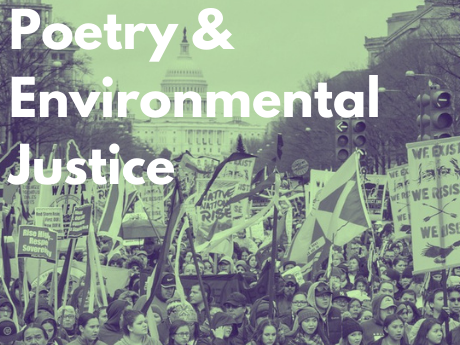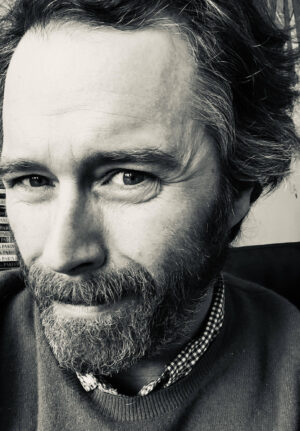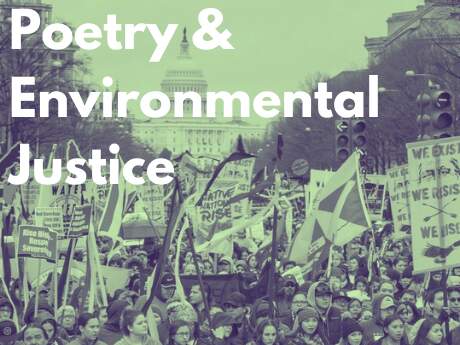Poetry & Environmental Justice
Dan Chiasson on “Watching Blackbirds Turn to Ghosts” by Rachel Eliza Griffiths

Watching Blackbirds Turn to Ghosts
Tomoko and I talk a long time
about the gestures of a falling
leaf in autumn.
On the antenna outside
I watch a cloister of blackbirds
who are so still
they become the very shadows of blackbirds.
“The falling leaf is universal,” she says
at one point.
We keep the leaf and its archetype
suspended in the air a bit longer
by talking slowly, in wonder,
while admitting it’s consistently useless for us
to pretend to be clever in our poems.
I think of any leaf’s shadow
going calmly to the street, beyond
the street, beyond the syntax of rot.
The morning I’d seen a woman
twisted like paper
at the bottom of a long bridge.
“Everyone will always watch leaves
fall in fall. Everyone will know this ––
what it means –– the simplicity
of the fall . . .”
Reprinted with the permission of the author.
“Tomoko and I talk a long time/about the gestures of a falling/leaf in autumn”: two time-signatures collide in the opening lines of Rachel Eliza Griffiths’s poem “Watching Blackbirds Turn to Ghosts”. Or, perhaps, three: the luxurious unspooling of a conversation between friends; the soft, pirouetting fall of a leaf; and the time of the poem itself, which expands horizontally, like a volleyed dialogue, and vertically, like a leaf driven by its own weight towards the earth.
Each of these phenomena (talk, leaf, poem) is presented as a construct shaped by choices people make. A conversation is one kind of language game; a poem, another; a “leaf”—the metaphor is up for grabs, in dispute, contested—a third. Falling leaves, of course, have a history in poetry. “O hushed October morning mild,” writes Robert Frost:
Beguile us in the way you know:
Release one leaf at break of day;
At noon release another leaf;
One from our trees, one far away.
Frost imagines their “release” but not their entire trajectory. Griffiths, though, tracks the entire journey of “any leaf’s shadow/going calmly to the street, beyond/the street, beyond the syntax of rot.” This “leaf” is a sentence, with its own “syntax” distributed not across the horizontal axis but the vertical and temporal plane of decay and disappearance.
My class and I read this poem together on a spit of forest jutting out into Lake Waban, one cold and rainy October afternoon in the fall of 2020. We were in masks. The pines and oaks, already socially distanced, provided safe places to lean or sit. We encountered it in our class text, an anthology edited by Camille T. Dungy, Black Nature: Four Centuries of African American Nature Poetry, which includes many leaves, many poems about leaves. And so, several other time signatures presented themselves: where were we on the awful pandemic timeline? In October of last year, were we nearing the end, or merely headed into a new phase, a reset, of our white supremacist Presidency and Federal Government? And did those “four centuries” of nature poetry by Black Americans represent a steady line of progress and empowerment? After the summer the country had put its Black citizens through, it certainly didn’t appear so.
The poem’s black and white title suggests that there are no metaphors free of social and political meaning: for a brilliant discussion of the long history of the racial formation of metaphor, see Cord Whitaker’s Black Metaphors: How Modern Racism Emerged from Medieval Race-Thinking (University of Pennsylvania Press, 2019). The range of possible meanings of “blackbird” is the focus of one of the most thrilling poems of the Twentieth Century, Wallace Stevens’s “Thirteen Ways of Looking at a Blackbird”; yet one “way of looking” at Stevens, one that he did not anticipate, is through the lens of his own racism. Storybook “ghosts” draped in sheets with eyeholes snipped out look, in the mind’s eye, like Klansmen from a Philip Guston canvas.
“The falling leaf is universal,” argues Tomoko. It may well be: but its terms are culturally and historically marked. Griffiths’s own view, which emerges late—almost as a postscript—forces an eleventh hour reevaluation of the entire dialogue in light of witnessed trauma:
This morning I’d seen a woman
twisted like paper
at the bottom of a long bridge.




